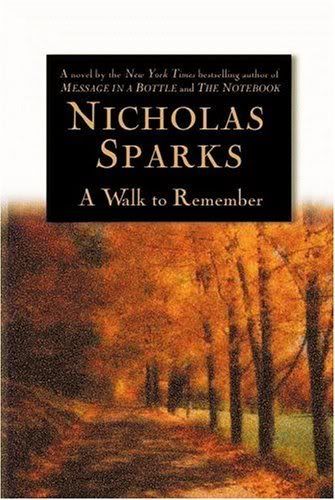If any of you have ever read A Walk to Remember by Nicholas Sparks, then read on. If you have not read it, then either go read it right now or don't read any further below.

If you have read it, then I'm sure you've gotten in some kind of debate about whether or not Jamie Sullivan lived or died in the end of the book. I believe she lived. But I found on Nicholas Spark's website that he is asked that question and I liked his answer! (I think he agrees with me.)
Did Jamie live or die at the end of the novel?
As I mentioned in the notes, this is the most frequently asked question I receive through the mail. As far as I can tell, about 70% of the people think Jamie passed away, another 30% believe she lived, and when asking the question, they offer "proof" for their reasoning.
Who once said that good books inspire debate?
There are a number of things that I have to explain before I get into the answer so you can understand my reasoning. Part of it goes back to Message in a Bottle. (For those who skipped the section on Background information for Message in a Bottle, you may want to go back before you read on for a fuller understanding). In a nutshell, while many readers loved the ending of that novel, a great many were furious with me for it. Really furious. This was on my mind while writing the novel, and part of me thought that if I killed off another major character, my readers would never forgive me.
Nonetheless, when I started the novel, I knew that Jamie was going to die. Every page, every scene, every chapter was written with that idea and it continued to proceed that way right up until the end of the novel, when the time came to write those words.
And strangely, I couldn't do it. I just couldn't do it. No matter how hard I tried, I couldn't.
Why? Because by that time, I'd grown to love Jamie Sullivan. I marveled at her strength and faith, and I was proud of everything for which she stood. And I didn't want her to die.
So I found myself in a dilemma.
Also, keep in mind that the story was also inspired by my sister, who was very much alive as I neared the end of the novel. Since it was inspired by her, I began to think, and she was alive. . .
I remember leaning back in my chair and absently scratching my chin, wondering what to do. Because of the story, because of all that I had written with her death in mind, because she was growing weaker and weaker throughout the story, it would have been dishonest (and frankly, very manipulative), to have Jamie suddenly cured. I could imagine some readers reaching the end and thinking, If that was the case, why the big build-up with her sickness? Others might close the book and think the entire novel was believable up until that point. I didn't want either of those impressions of the novel.
So what was I to do? I didn't want her to die, and couldn't write those words. Yet, I plainly couldn't let her live, either. I opted for the only solution, the solution that best described the exact feeling I had with regard to my sister at that point: namely, that I hoped she would live.
That's the ending, folks. I wanted readers to finish with the hope that Jamie lived.
As to whether she actually lived or died, it's ambiguous and purposely meant to be that way. If you wanted Jamie to live, she lived. If you knew that Jamie would die, she died.
As for me, (and I'm not the final say -- I wrote the characters, but reader's know them just as well as I do), I thought there was a good chance that Jamie lived.
At least, I hoped so.
What did the last sentence mean?
Either the miracle was that Jamie lived (if that was the ending you imagined) or that Landon had experienced the miracle of first love and it had redeemed him (if you imagined that Jamie died.)







2 comments:
Oh this is a debate we will always have. I wish I thought like you though and thought she had lived.
p.s.
a walk to remember was read to me in the 8th grade by my english teacher and i have read a bunch of his books since... and love every one of them.
i love being a sap. :)
Post a Comment